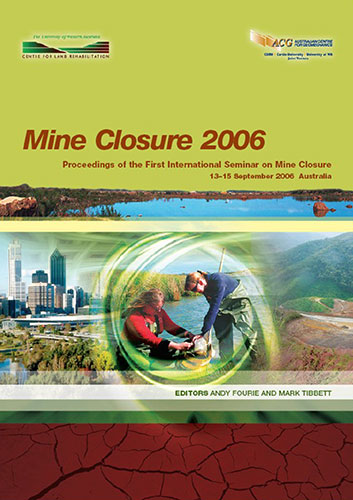Better Closure Cost Estimates

|
Authors: Watson, AH |
DOI https://doi.org/10.36487/ACG_repo/605_41
Cite As:
Watson, AH 2006, 'Better Closure Cost Estimates', in AB Fourie & M Tibbett (eds), Mine Closure 2006: Proceedings of the First International Seminar on Mine Closure, Australian Centre for Geomechanics, Perth, pp. 493-497, https://doi.org/10.36487/ACG_repo/605_41
Abstract:
The most important element of sustainability in mining is that we stay in business. There are over 23000 abandoned mine openings from activity pre-1970, in the State of Colorado alone. Those early miners did not consider the cost associated with any activity external to the extraction of ore, and made no provision for retiring their mining assets when the lode played out. Approximately 3500 of those disturbances have been closed with Federal and State funds since the inactive mines program was implemented in the 1980s, and the State of Colorado is responsible for closing the rest of them eventually. There are currently approximately 6000 mines in Colorado permitted under the post-1970s mining law, requiring reclamation bonding. This is just one example of the many mining districts around the world where we have work to do.
References:
Anonymous (2006) Mined land reclamation in Colorado: an overview. State of Colorado division of minerals and
energy.
Bartos, P. (2003) Quoted in Hard Rock Miner's Handbook Rules of Thumb, Edition 3. Mackintosh Engineering, rule
7.18.
PMI (2000) Project Management Body of Knowledge (PMBOK) 3rd Edition, Project Management Institute, Chapter 5.
Rad, P. (2002) Project Estimating and Cost Management, Management Concepts, Vienna (USA), pp. 43-66.
Akintola, A. and Fitzgerald, E. (2000) A survey of current cost estimating practices in the UK, Construction
Management & Economics, 2000, Vol. 18, Issue 2, Taylor and Francis, London, pp. 161-172.
Lorance, R. and Wendling, R. (1999) Basic Techniques for Analyzing and Presentation of Cost Risk Analysis, Crystal
Ball, Denver.
Financing Closure
Mine Closure 2006, Perth, Australia 497
© Copyright 2025, Australian Centre for Geomechanics (ACG), The University of Western Australia. All rights reserved.
View copyright/legal information
Please direct any queries or error reports to repository-acg@uwa.edu.au
View copyright/legal information
Please direct any queries or error reports to repository-acg@uwa.edu.au